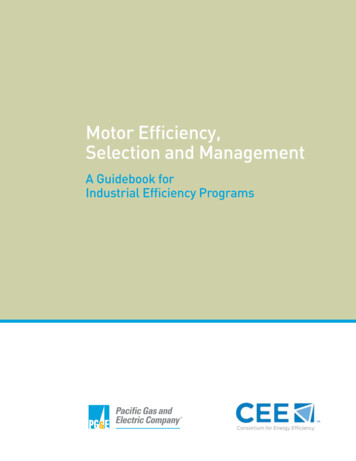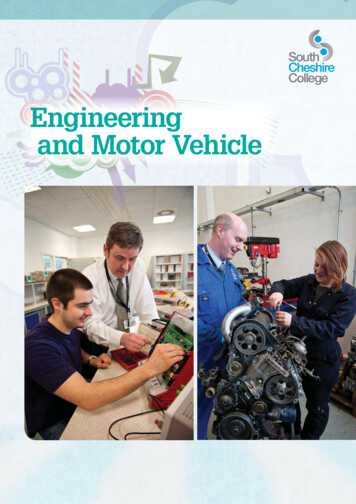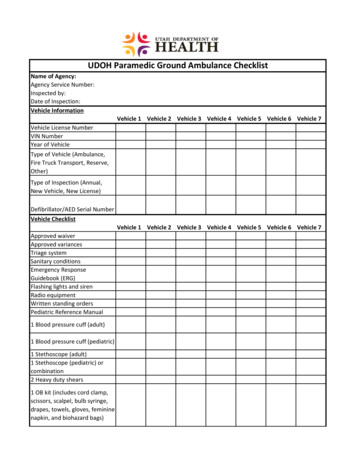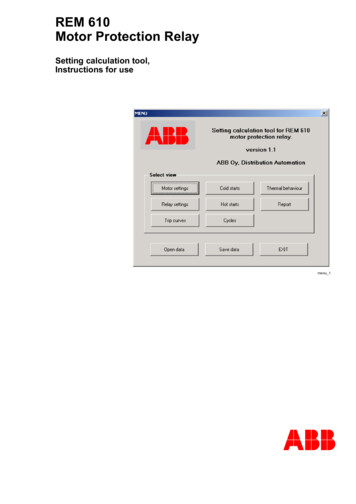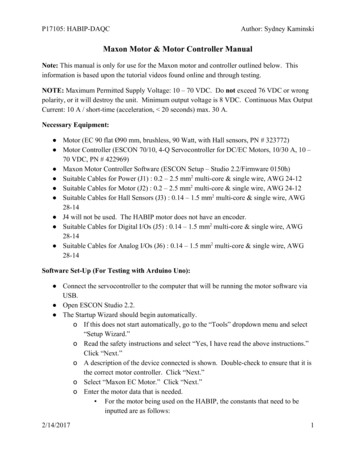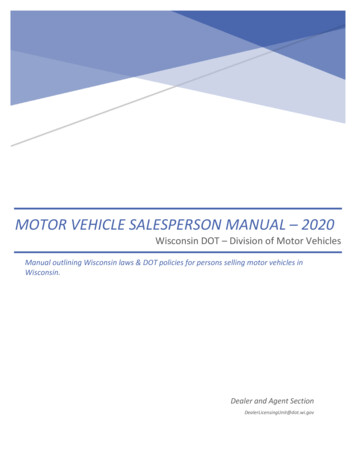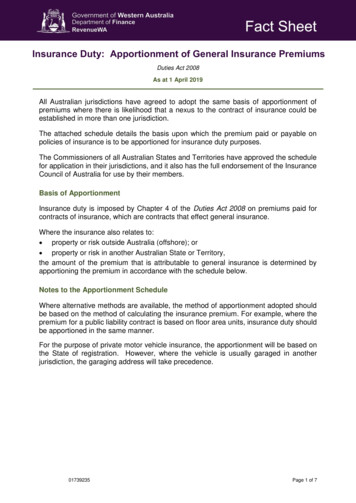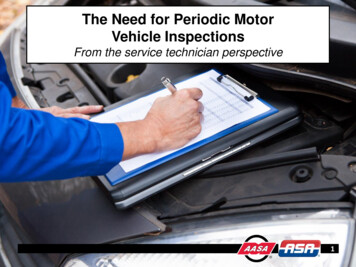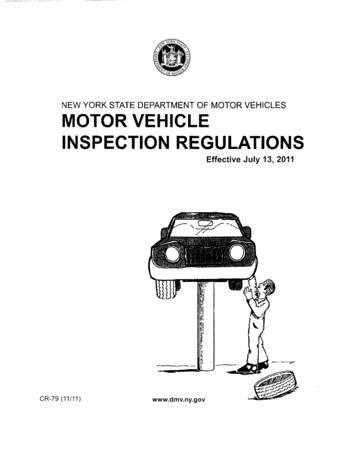
Transcription
Law Enforcement OfficerMotor Vehicle Crash InvestigationLEO 2016-03September 25, 2018Officer dies in motor vehicle crash at an intersectionwhile responding to a shots fired call – South CarolinaEXECUTIVE SUMMARYOn November 7, 2015, a 37 year old municipal police officer wasfatally injured when her patrol car was struck by another lawenforcement vehicle on a city roadway while responding to ashots fired call.The officer was en-route to her primary patrol region afterescorting a suspect to the city jail when she responded to a shotsfired call from municipal dispatch. Multiple university andmunicipal police officers were working in the same vicinity andsimultaneously responded to the shots fired call. As the municipalpolice officer was traveling westbound, running lights and sirens,she entered an intersection against the traffic control device. Atthe same time, a university police officer traveling northbound,also running lights and siren, entered the same intersection. Thenorthbound university patrol vehicle crashed into the westboundmunicipal patrol car. Both officers were taken to a local medicalcenter by ambulance. The municipal police officer died frominjuries sustained in the crash. The university police officerreceived serious injuries.Photo 1. Municipal patrol unit atcrash scene (Photo courtesy of SouthCarolina Highway Patrol)CONTRIBUTING FACTORSKey contributing factors identified in this investigation include: Two vehicles entered intersection at the same time Speed of vehicles Multiple agency and patrol car response Potential adrenaline overload Poor line of sight at the intersectionKEY RECOMMENDATIONSNIOSH investigators concluded that, to help prevent similar occurrences: State, county, and municipal law enforcement agencies should consider establishing, training, andenforcing standard operating procedures (SOPs) that require drivers to come to a complete stop at redtraffic lights and stop signs during responses and proceed through intersections only after ensuring itis safe to continue.1
Law Enforcement OfficerVehicle Crash Investigation#LEO 2016-03 SC State, county, and municipal law enforcement agencies should consider establishing, training, andenforcing SOPs that limit the speed of a patrol unit during responses. State, county, and municipal law enforcement agencies and training academies should considertraining and emphasizing Tactical Arousal Control Techniques to enhance officer’s ability to combatnegative effects of ‘adrenaline dump’ that can occur when responding to hot calls. State, county, and municipal law enforcement agencies should establish and enforce a standardoperating policy that requires all officers to wear a seatbelt while operating or riding in a patrol unit. State, county, and municipal agencies should consider developing and implementing interagencyjurisdictional policies that outline roles and responsibilities in situations or physical locations where amultiple agency response is possible.NIOSH Law Enforcement Officer InvestigationsThe National Institute for Occupational Safety and Health (NIOSH), an institute within the Centers for Disease Control and Prevention (CDC), is thefederal agency responsible for conducting research and making recommendations for the prevention of work-related injury and illness. Through aninteragency agreement, the National Institute of Justice funded a NIOSH pilot program to investigate line-of-duty deaths of law enforcement officersresulting from vehicle crashes and being struck by vehicles while responding to roadside emergencies and making traffic stops. These NIOSHinvestigations are intended to reduce or prevent occupational deaths and are completely separate from the rulemaking, enforcement and inspectionactivities of any other federal or state agency. NIOSH does not enforce compliance with State or Federal occupational safety and health standards anddoes not determine fault or assign blame. Participation of law enforcement agencies and individuals in NIOSH investigations is voluntary. Under itsprogram, NIOSH investigators interview persons with knowledge of the incident who agree to be interviewed and review available records to developa description of the conditions and circumstances leading to the death(s). Interviewees are not asked to sign sworn statements and interviews are notrecorded. The agency's reports do not name the deceased officer, the law enforcement agency or those interviewed. The NIOSH report's summary ofthe conditions and circumstances surrounding the fatality is intended to provide context to the agency's recommendations and is not intended to bedefinitive for purposes of determining any claim or benefit. The NIOSH report is not intended as a legal statement of facts. This summary, as well asthe conclusions and recommendations made by NIOSH, should not be used for the purpose of litigation or the adjudication of any claim.2
Law Enforcement OfficerVehicle Crash Investigation#LEO 2016-03 SCINTRODUCTIONOn November 7, 2015, at approximately 22:16, a municipal police officer was fatally injured when thepatrol car she was driving was struck by another law enforcement vehicle. On September 15, 2016, aninvestigation of this incident was conducted by a team from the National Institute for Occupational Safetyand Health (NIOSH) and National Institute of Justice (NIJ). The investigation team reviewed the officer’spersonnel and training files, coroner’s report, dispatch recordings and logs, highway patrol photographs,police dashcam videos, traffic cameras, the highway patrol accident investigations team crash report,witness statements, and the agency’s standard operating procedures. Interviews were conducted withmembers of the municipal law enforcement agency, as well as members of the fire department andemergency medical services that were present at the crash scene. Interviews were also conducted withdispatchers and the highway patrol accident investigation team. The incident site was examined andphotographed by the NIOSH/NIJ investigators.LAW ENFORCEMENT AGENCYThe municipal police department employs 409 sworn officers who protect and serve a population of133,803 within 132 square miles [USCB 2015]. The department is a full-service agency with three shiftsstaffed for 24/7 coverage. The agency has three major bureaus: administrative, operations, and specialservices. The agency is also divided into five patrol regions: North, South, East, West, and Metro. Eachpatrol officer is assigned to work in a specific region; however, if an officer is in an area other than theirown when a broadcast call is made by dispatch, they are to respond to the call to provide assistance. In2015, officers answered over 163,500 calls for service and made 5,921 arrests.TRAINING AND EXPERIENCEThe officer worked in law enforcement for approximately 20 years. Prior to joining the municipal policedepartment in 2011, she served as a military police officer where she earned multiple medals andcommendations. The officer had a Bachelor of Science degree in Criminal Justice.The South Carolina Code of Laws, Title 23, Chapter 23 sets the minimum requirements to become asworn officer in South Carolina including: age of at least 21 years, U.S citizen, and hold a high schooldiploma [South Carolina Legislative Council 2014]. Additionally, the municipal department requires avalid class ‘D’ driver’s license with an acceptable driving record, no criminal record, and no DUIs in thepast ten years. Candidates meeting these qualifications can apply for employment at the municipaldepartment and, if hired, will then be required to successfully meet the requirements for the department’sBasic Candidate School (twelve weeks), the South Carolina Criminal Justice Academy’s (SCCJA) BasicLaw Enforcement School (twelve weeks), and the department’s field training program (forty-six workingdays).The department’s eight-week Basic Candidate School (BCS) helps to prepare new officer’s tosuccessfully complete the SCCJA. This is completed by receiving an 80% on all tests excluding Taserwhich requires a 90%. The BCS curriculum is a mix of classroom-based and hands-on training thatincludes a wide range of topics including: region familiarization, basic marksmanship, emergency vehicleoperations course (EVOC), courtroom procedures, defensive tactics, dispatch radio, report writing, andarrest procedures. The EVOC includes a precision course at low speed and an emergency responsecourse. After graduation the candidate moves on to the SCCJA Basic Law Enforcement School.3
Law Enforcement OfficerVehicle Crash Investigation#LEO 2016-03 SCThe SCCJA Basic Law Enforcement School provides officers with twelve weeks of training on thenecessary knowledge, skills, and abilities to perform the duties of a certified law enforcement officer. TheSCCJA is a dormitory style academy located in the city of Columbia, SC. The curriculum includes typicallaw enforcement topics such as criminal law, civil liability, use of force, and defensive tactics. Thecurriculum also includes over 20 hours of driver training including braking, road vehicle dynamics, andoff road vehicle dynamics [Tatum 2017]. The driver training is administered by a SCCJA certified drivinginstructor and candidates are required to successfully complete a law enforcement emergency vehicletraining course. The candidate must pass all areas before receiving certification from the LawEnforcement School. After graduation from the SCCJA, the municipal police department requires thecandidate to complete a 46 day Field Training Program.Any candidates who received law enforcement training as U.S. military police may submitsatisfactory proof of successful completion and a verified copy of the courses taken. Training will bereviewed on a case by case basis and each candidate will be given credit for any training deemedequivalent to training offered by the SCCJA [South Carolina Legislative Council 2015]. All candidatesmust successfully complete a training program approved by the Council.South Carolina law enforcement officers are required to complete forty Continuing Law EnforcementEducation (CLEE) hours in a three-year period. The forty CLEE hours must include one legal updatecourse and one domestic violence course. The remaining required CLEE hours in the three-year periodmay come from any source approved by the Academy [South Carolina Legislative Council 2015]. Thereis no requirement for continuing education hours for driver training. At the time of the incident, theofficer was up to date on all of her annual training requirements.ROAD AND WEATHER CONDITIONSThe crash occurred in the center of an intersection of two city roadways. A traffic light was present fortraffic control and the intersection was lit by several streetlamps. The surface of the city roadways wasasphalt and the posted speed limit was 30 mph. The roadway approaching the scene of the crash from thesouth had an upward grade and two lanes of traffic travelling in each direction. A yellow double solidcenter line divides the opposing traffic lanes and a single dashed white line divides the traffic lanes. Theroadway approaching the scene from the east had a downward grade and one lane of traffic travelling ineach direction with a yellow double solid center line dividing the opposing traffic.From archived weather reports, at the time of the crash, the temperature was approximately 70 degrees Fand the dew point was approximately 66 degrees F. The skies were overcast with no measurable windgusts and visibility was reported to be ten miles [Weather Underground 2015]. Weather was notconsidered a factor in this incident.INVESTIGATIONThe following description of officers’ activities during this incident are based on the NIOSH/NIJ team’sevaluation of security and dash camera videos as well as a review of the state police accident teaminvestigation file.4
Law Enforcement OfficerVehicle Crash Investigation#LEO 2016-03 SCIn the evening of November 7, 2015, a municipal policeofficer traveled outside of her normal patrol area to escort asuspect to the city jail. After leaving the city jail, she brieflystopped at a local fast food restaurant to order food. Atapproximately 22:15, municipal dispatch announced a shotsfired call across all municipal radio bands and requested thatall units respond. The original address announced bydispatch for the location of the shots fired was incorrect.After receiving additional calls from witnesses, themunicipal dispatcher broadcasted the correct location, whichwas a heavily populated entertainment area of the city thatencompassed many public restaurants and bars. The correctlocation was approximately one mile south of the firstaddress given.Photo 2. Photo of the universitypatrol 4x4 utility vehicle at crashscene (Photo courtesy of SouthCarolina Highway Patrol)At the time of the call, there were several municipal anduniversity police officers in the vicinity (see diagram 1). Atthe time of the dispatch call, the deceased officer (labeled 1on Diagram 1) had just left a fast food restaurant and wastraveling northbound on Street A, presumably returning to her primary patrol area. At the same time, 3university police officers (labeled 3, 4, and 5 on the diagram) were located several city blocks away, tothe South East. The deceased officer and the university police officers all responded to the call, followingthe routes noted on the diagram.Using the deceased officers’ patrol car GPS coordinates, her location relative to the dispatch calls wasdetermined. During her travel time down the three city blocks of Street A, the dispatcher confirmed theexact location of the shots fired. After hearing the exact location of the shots fired call, the deceasedofficer passed another municipal patrol car with lights and siren activated (labeled 2 on the diagram),headed in the opposite direction. The deceased officer made a U-turn to follow municipal patrol car 2;activated lights and sirens; and responded to dispatch she was in proximity of the call and would assistuntil back-up arrived. She increased her speed from approximately 26 mph to 44 mph and turned westfrom Street A onto Street B, which has a downhill grade.The crash was recorded by two traffic cameras mounted on Street B. From these recordings, theMunicipal Police Officer labeled 2 can be seen approaching the intersection, traveling westbound onStreet B, and coming to a brief stop at the intersection before proceeding straight through the intersection.The traffic light is red at this time. A few seconds later, Municipal Police Officer 1, the deceased officer,can be seen approaching the intersection. The traffic light facing her direction of travel is still red.Municipal Police Officer 1 does not reduce her speed and proceeds through the intersection against thetraffic control device in an apparent straight forward direction. She is traveling 64 mph and the postedspeed limit was 30 mph. Upon entering the intersection, she is hit on the driver’s side door by theUniversity Police Officer 3 who entered the intersection with a green light travelling 76 mph northboundon Street E. The posted speed limit in the area was 30 mph. After impact, her patrol vehicle continued offthe roadway and struck a curb, mailbox, concrete wall, and palm trees before coming to rest.According to discussions with dispatch personnel, university police officers have their own separatedispatch service. However, the university dispatch and the university police officer in charge monitorsmunicipal dispatch for life safety calls and can dispatch university police officers to assist municipalpolice officers. Officers from both law enforcement agencies are able to communicate with one anotherby walkie talkies. It is believed the university police officer in charge heard the shots fired call frommunicipal dispatch and broadcasted the call to university police officers.5
Law Enforcement OfficerVehicle Crash Investigation#LEO 2016-03 SCBased on their location at the time of the shots fired call, there were several potential routes to take to thelocation of the call. University Police Officer 5 traveled north then east before turning north onto StreetA; at this time the University Police Officer 5 was travelling toward Municipal Police Officer 1.Municipal Police Officer 1 turned west on Street B and the University Police Officer 5 followedimmediately behind. University Police Officers 3 and 4 travelled westbound on Street D and turned rightonto Street E, heading northbound. This street had an upward grade. The University Police Officer 3 wastraveling at approximately 76 mph when he approached the green traffic light at the intersection of StreetB and Street E. The posted speed limit was 30 mph. Immediately upon entering the intersection,University Police Officer 3 struck the Municipal Police Officer 1 on the driver’s side door. After impact,the University patrol vehicle 3 also continued off the roadway and struck a curb, concrete wall, and afence (see Diagram 2).Diagram 1. Location and Route of Multiple Agencies and Officers at theTime of the Shots Fired Call6
Law Enforcement OfficerVehicle Crash Investigation#LEO 2016-03 SCDiagram 2. Impact of municipal and university patrol units(Courtesy of South Carolina Highway Patrol)7
Law Enforcement OfficerVehicle Crash Investigation#LEO 2016-03 SCShortly after the crash, multiple emergency response units responded to the scene, including several lawenforcement agencies, EMS, and fire. The Municipal Police Officer 1, who was not wearing a seatbelt,was trapped inside the patrol unit and was extricated by EMS and law enforcement officers. She wasgiven first aid on the scene and immediately transferred to the local trauma hospital by ambulance whereshe was pronounced dead. University Police Officer 3, who was not wearing a seat belt and sufferedserious incapacitating injuries, was also transported to the trauma care hospital where he later recoveredfrom his injuries. At approximately 02:00, the South Carolina Highway Patrol Multi-DisciplinaryAccident Investigation Team arrived on-site to investigate the incident.Photo 3. Municipal patrol unit involved in crash (Courtesy of South Carolina Highway Patrol)8
Law Enforcement OfficerVehicle Crash Investigation#LEO 2016-03 SCCONTRIBUTING FACTORSOccupational fatalities are often the result of one or more contributing factors or events that result in theinjury or fatality. NIOSH/NIJ investigators identified the following contributing factors in this incident: Two vehicles entered intersection at the same time Speed of vehicles Multiple agency and patrol car response Potential adrenaline overload Poor line of sight at the intersectionCAUSE OF DEATHThe County Coroner’s Office listed the cause of death as multiple blunt force injuries to the head andtorso due to a motor vehicle accident.RECOMMENDATIONS/DISCUSSIONThe following recommendations focus on methods that could eliminate or mitigate the factors identifiedas contributing to this incident. They are not aimed at any agency, but are intended for consideration bylaw enforcement agencies, state and local governments and departments of transportation nationwide, aswell as safety researchers, and the general public.Recommendation #1: State, county, and municipal law enforcement agencies should considerdeveloping and implementing standard operating procedures (SOPs) that require drivers to come to acomplete stop at red traffic lights and stop signs during responses and proceed through intersectionsonly after ensuring it is safe to continue.Discussion: The goal of a law enforcement agency when responding to an emergency is to arrive on thescene as quickly as possible. In order to arrive safely, operators of emergency vehicles should be aware oftheir specific state and agency regulations related to emergency driving. South Carolina law (Chapter 5,Section 56-5-760.A) dictates that a driver of an authorized emergency vehicle, may exercise certainprivileges when responding to an emergency call; however, this does not relieve the operator from theduty and responsibility to drive with regard for the safety of others. These privileges include proceedingpast a red stop signal or stop sign, but only after slowing down, as may be necessary for safe operationand clearing the intersection [South Carolina Legislative Council 1990]. At the time of the incident, thepolicy of the municipal agency was to ‘exercise due care for the safety of others when entering theintersection on a red light while on an emergency response’.Video footage of the incident was obtained from a nearby traffic camera. In addition, dashcam videofootage from a university patrol unit travelling behind the deceased officer’s car was obtained. Thesevideos show the municipal police officer was running lights as she approached the intersection with a redlight in her direction. Per the airbag control module data, the municipal patrol car was traveling at 64 mphwhen she entered the intersection. The videos show that the municipal patrol car did not slow down orstop at the red light. Immediately after entering the intersection against the red traffic light, the municipalpatrol car was struck on the driver’s side door by a university patrol car also responding to the shots firedcall with lights and siren.9
Law Enforcement OfficerVehicle Crash Investigation#LEO 2016-03 SCAfter the incident, the municipal agency’s policy was changed to, ‘All responding vehicles must come toa complete stop before entering an intersection, counter to the established traffic control device’. A policyand procedures manual is the cornerstone of strong communication between the agency and officersregarding the agency’s operations. Strong policies are those that explicitly define expectations and areclear in their language. For example, as dictated in the prior agency policy, ‘due care’ may mean differentthings to different officers and result in different behaviors and outcomes. The municipal agency changedthe language of their intersection crossing policy to be more precise with a specific objective behavior –‘ come to a complete stop’.Prior to the incident, the university agency policy required officers to: “Proceed past a traffic controldevice, only after slowing down and clearing the intersection for oncoming pedestrian and vehicletraffic”. After the incident the university policy was revised to include specific instructions for clearingan intersection emphasizing the need to clear the intersection even if the officer has the right of way. Thisrevised intersection policy also states that: “An officer will only proceed at a speed allowing safe stoppingprior to entering the intersection.”Although a model specific to law enforcement agencies is not available at this time, The InternationalAssociation of Fire Chiefs (IAFC) has developed a guide for developing policies related to the operationof emergency vehicles during a response that may have applicability for law enforcement agencies [IAFC2009]. This guide recommends, “The fire department emergency vehicle shall come to a full stop beforeentering a negative right-of-way intersection (red light, flashing red light, or stop sign), blind intersection,or any intersection where hazards are present and/or the driver cannot account for all oncoming trafficlanes. The emergency vehicle shall not enter the intersection until all approaching traffic has yielded theright-of-way and it is safe to proceed. The emergency vehicle driver shall ensure that all approachingvehicles in all lanes have yielded the right-of-way before advancing.” While this policy is morerestrictive than many emergency responder state laws, it is written to ensure safe passage for theemergency responder, as well as fellow public safety professionals and civilians. Law enforcementagencies should consider modifying and adopting similar intersection crossing policies.Recommendation #2: State, county, and municipal law enforcement agencies should considerdeveloping and implementing SOPs that limit the speed of a patrol unit during responses.Discussion: In the state of South Carolina, another privilege authorized to operators of emergencyvehicles while responding to a call is the option to ‘exceed the maximum speed limit if he does notendanger life or property’ (South Carolina law, Chapter 5, Section 56-5-760) [South Carolina LegislativeCouncil 1990]. At the time of the incident, the policy of the municipal agency during a Code 3(emergency) response was ‘officers shall not exceed the posted speed limit by more than 20 mph(excluding motor vehicle pursuits)’. The University law enforcement agency does not have a speed cappolicy; however, a program is in place to monitor the speed of patrol units and alert administration whenpre-established set speeds are exceeded. Law enforcement officers and agencies must balance the primarygoal of quickly arriving to an emergency with that of arriving safely.At the time of the crash, data from the patrol unit’s airbag control module indicated the patrol car wastraveling at 64 mph. The posted speed limit was 30 mph. The officer was traveling 34 miles over theposted speed limit which was in excess of the agency’s 20 mph policy. Higher speeds are linked with anincreased likelihood of a motor vehicle crash [SWOV 2012]. Nearly all research studies conclude thatcrash rates increase when speed increases [Institute of Transport Economics 2009]. Increased speedreduces the amount of information a driver can visually see and limits the time available to receive andprocess this information [AASHTO 2001]. Higher speeds are also linked with increased injury severity10
Law Enforcement OfficerVehicle Crash Investigation#LEO 2016-03 SCfrom crashes [SWOV 2012]. The likelihood of a driver being involved in a fatal crash increases whentheir speed is over the posted speed limit [Road Accident Research Unit Adelaide University 2001]. Thisresearch also showed that small reductions in speed can lead to significant reductions in motor vehiclecrash fatalities.One of the primary tenants of the law enforcement community is to arrive safely at scenes in a timelymanner. It is a commonly held belief in the law enforcement community that faster response times leadto better criminal justice outcomes such as lower crime rates, as well as increased public satisfaction withthe police. However, the reality of trying to get to an incident faster and taking more risks, in doing so,can result in a catastrophic incident. Officers must show restraint and maintain calmness duringemergency driving. Data show that in regards to crime detection, response time matters only within thefirst minute after a crime takes place [Bayley 1996]. Data show that police action and response past theone minute mark becomes nearly irrelevant [Sherman et al. 1997]. Research has also shown that responsetimes also have little impact on arrest rates [Kansas City Police Department 1978].Response time is also not a strong, direct determinant of citizen satisfaction. The public image of thepolice is complex. Historically, police departments have used crime-related measures such as crime rates,clearance rates, and response times to measure citizen satisfaction [George Mason University 2001].Studies have found that citizen satisfaction with response times is affected by a range of other variables[Brown and Coulter 1983]. Other studies have shown that response time does influence citizen’s overallsatisfaction with police, but so does individual officer actions once on the scene [Percy 1980]. Agenciesand officers should recognize that while small decreases in response times may not impact criminaljustice outcomes or citizen satisfaction, it could save law enforcement lives and enable officers to arriveon scene safely.No law enforcement organization or stakeholder group has developed and encouraged a model set ofpolicies related to the operation of emergency vehicles during a response; however, one mechanism topotentially improve officer safety during responses is speed caps. Many law enforcement agencies haveimplemented p
Law Enforcement Officer Vehicle Crash Investigation #LEO 2016-03 SC The SCCJA Basic Law Enforcement School provides officers with twelve weeks of training on the necessary knowledge, skills, and abilities to perform the duties of a certified law enforcement officer. The SCCJA is a dormitory style academy located in the city of Columbia, SC.

